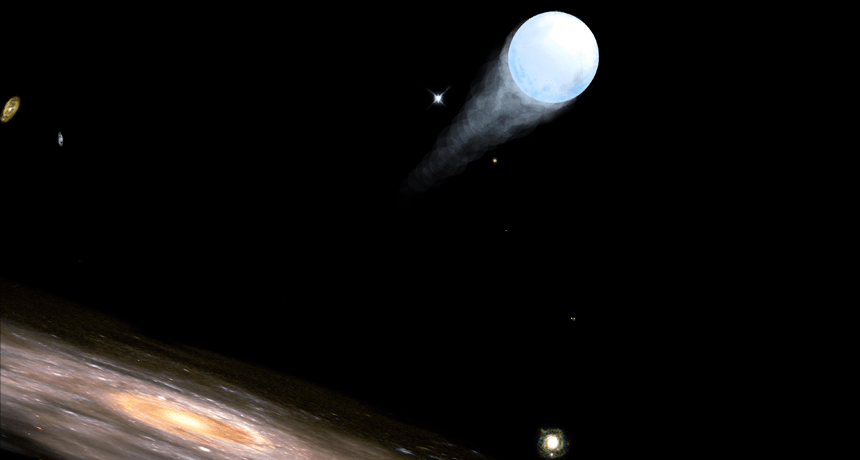Ever heard of the fastest star in existence? Probably not. But they actually do exist. Hypervelocity stars (HVSs) have recently captured the interest of astronomers and enthusiasts alike for their varied applications and scientific findings.
A hypervelocity star is a star that is ejected from the center of a galaxy at an extremely high speed (on the order of 1,000 km/s) as a result of interaction with a huge central black hole. In 1988, it was originally postulated that hypervelocity stars exist.
Members of the Milky Way’s halo, high-velocity stars move very quickly in very elliptical orbits around the galaxy’s center. The first hypervelocity star to be ever discovered was in 2005 by astronomers using the Multiple Mirror Telescope in Arizona spearheaded by Warren Brown. This was called SDSS J090745.0+024507 which is 71 kiloparsecs from the Sun and traveling at around 850 km/s (528 miles/s) toward the galaxy’s fringes (the so-called galactic halo).
In the succeeding 15 years, over 550 of them have been observed by various observatories all over the globe which sparked more interest in the fastest stars observed in the universe using new equipment and technology.
From these observations, astronomers were able to sub-classify high-velocity stars which we now know as hypervelocity stars, runaway stars, hyper-runaway stars, and fast halo stars. It’s pretty overwhelming that there are a variety of super-fast stars existing in our universe.
But what are hypervelocity stars? Hypervelocity stars (HVSs) are the fastest among the classification of high-velocity stars. They are especially interesting because they have achieved relativistic speeds, which is a fraction of the speed of light. Astronomers have estimated that with the right kind of gravitational acceleration, HVSs can reach 1/10th to 1/3rd the speed of light, that is roughly 30, 000 to 100, 000 km/s (18, 640 to 62, 130 mi/s). That is way too fast in anyone’s speedometer!
Hypervelocity stars have become important tools for understanding massive black holes and also offered a unique probe of galactic structure. Throughout their lifetime, these stars travel across most of the galaxy and even possess the velocity needed to escape the Milky Way. Furthermore, by measuring HVS’ movements across the sky, it has become possible to refine our knowledge of the shape of the Milky Way and the manner in which its dark matter is distributed.
A hypervelocity star orbiting each other must brush close to the giant black hole at the Milky Way’s center. One star is captured into orbit around the black hole, while its partner is released and flung into space by the immense gravity of the black hole.
Just as there is a possibility that our HVSs could escape the Milky Way and travel to other galaxies, so can HVSs of other galaxies travel to our own. The nearest galaxy where hypervelocity stars could originate from is the Andromeda spiral galaxy which is nearest to ours as it also has a central black hole that could occasionally send stars across space and arrive in our Milky Way galaxy. However, only long-lived stars can survive the long journey.
As amazing as this phenomenon is, one could not help but overthink: What if these hypervelocity stars pass by our planet and get pulled by the Earth’s gravity? What if it collides with Earth? Discoverer Warren Brown tells us that there is a slim possibility of a hypervelocity star colliding with our planet. He says that there is a lot of space between the Milky Way’s stars and very few hypervelocity stars are being thrown outward. He further states that the chances of any getting close to us are astronomical.
A gravitational slingshot requires a close pair of stars, according to astronomers. In a solar system where planets could only develop on the edges, around both stars in a wide orbit, those planets would be pulled away and lost to the cold, interstellar space when the star system went by the black hole. Fortunately, our planet and solar system were designed in this way; otherwise, these super-fast stars would have annihilated us.
Currently, there are 591 high-velocity stars, including at least 43 that are unbound to the Milky Way and have escape probabilities greater than 50% that had been discovered. The vast majority are big stars, with about 14% being metal-rich halo stars. To determine their origin, the scientists followed the orbits of 591 high-velocity stars back in time to learn more about their formation. They discovered that 15 percent of stars are from the Galactic center, 55 percent are from the Galactic disk, and 30 percent are extragalactic.
Hypervelocity stars have become instrumental in our pursuit of learning more about our galaxy. Because the Milky Way’s center is covered by dust and gas, astronomers have had difficulty studying the black hole and nearby stars. The discoveries of HVS inform scientists about the types of stars circling near the central black hole. Astronomers can now deduce what happened in the galactic center millions of years ago by examining patterns in the positions and ejection periods of hypervelocity stars.
Similarly, the hypervelocity stars could also be used as test particles to map the Milky Way’s visible-matter and dark-matter distributions is an intriguing application. Dark matter, according to the current paradigm, is made up of large, weakly interacting particles that gravitationally clump together in halos on the fringes of individual galaxies. While there is generally little data known about dark matter, hypervelocity stars could significantly help in mapping out this invisible-like component of our universe.
The sensitive measurements of hypervelocity stars disclose their dramatic history and what they can offer about our cosmic home. Astronomers will continue to search for other hypervelocity stars for this reason, and there are likely to be more. We may not be able to see the results of this endeavor in our lifetimes, but this epoch has contributed to the advancement of science.


